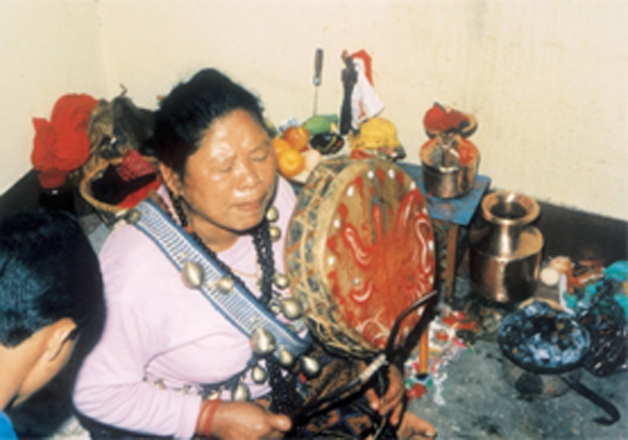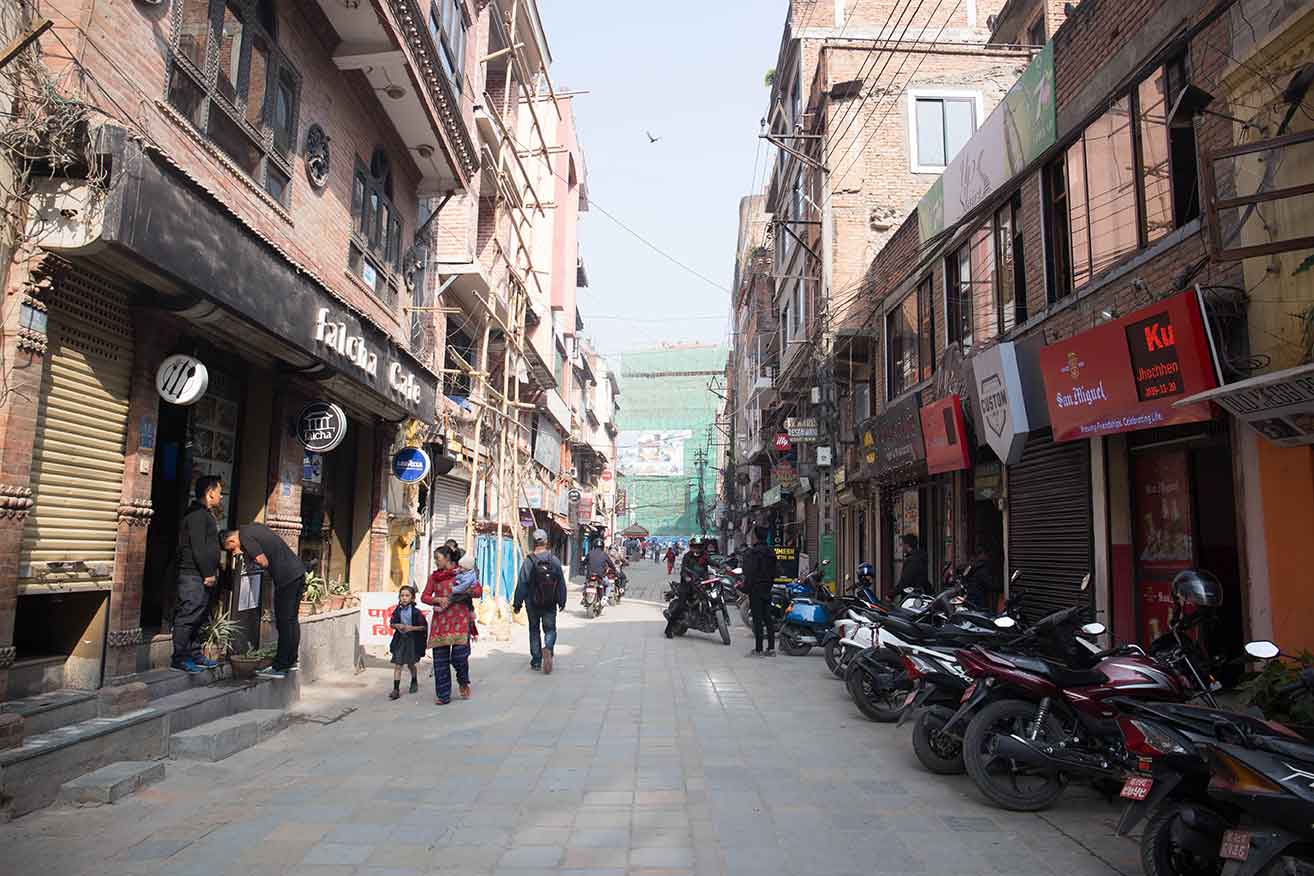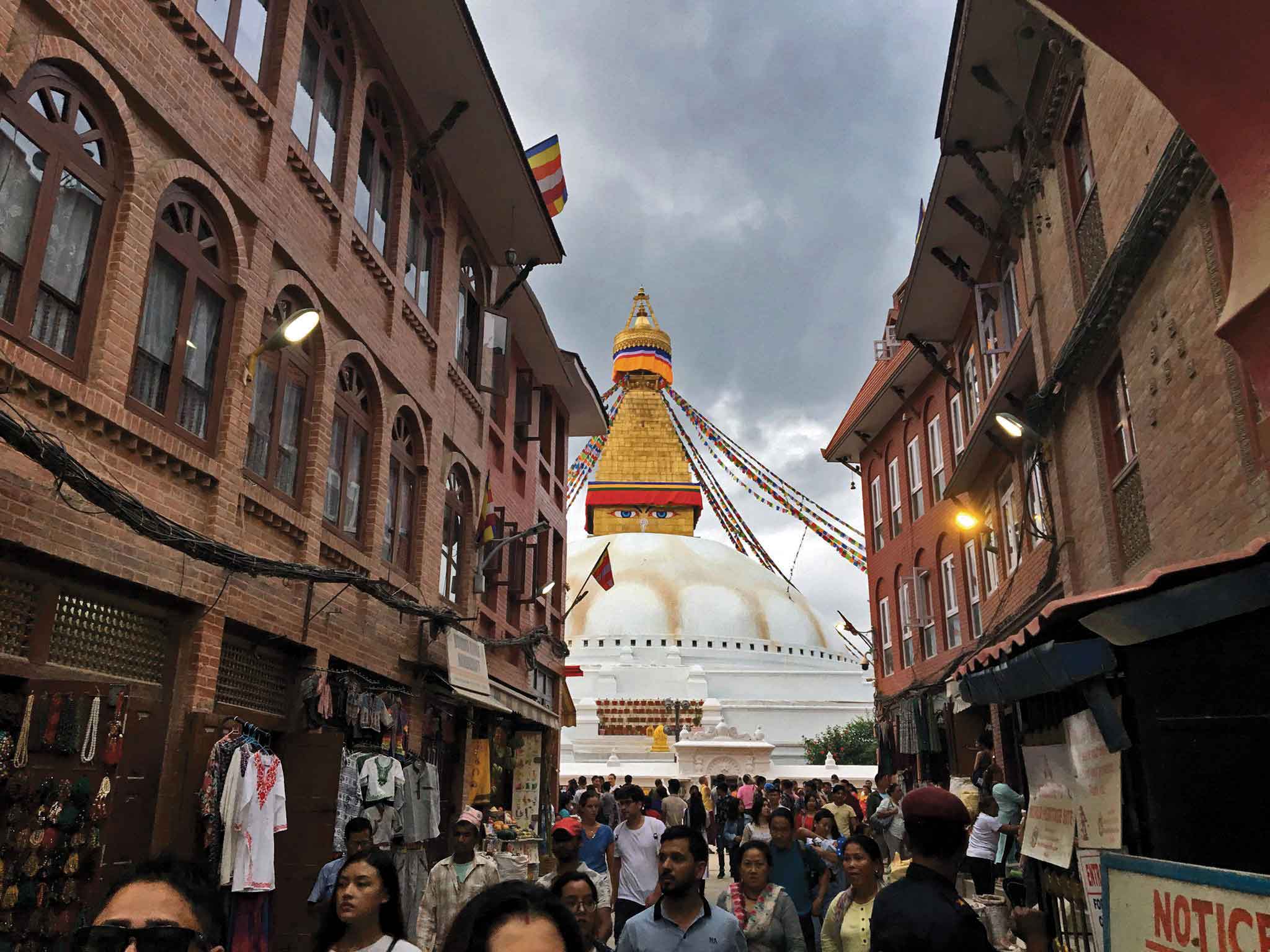“The shamans are “masters of spirits” and have developed techniques of control over them. They are able to utilize this power to combat evil spirits, and thereby exorcise or help those who suffer from spirits.” Shirokogoroff, 1935; Firth 1964.
“Shamans are the same all over the world,” says Larry Peters, who is a renowned scholar, and an initiated shaman in the Tibetan tradition. “Their rituals and methods may differ but their intentions and principles are the same,” he adds. This ancient knowledge passed down from shaman to shaman has withstood the test of time and survived side by side with modern medicine. Among these, there sometimes arrives a shaman who has been initiated by a Goddess or some other higher being. One such person is Aama.

Aama
‘Aama Bombo’ (Mother shaman), a Tamang Shaman from Boudha, recently attended a conference of women faith healers in Santa Fe, New Mexico, USA. “I will be attending another conference in Mexico in May 2006,” says Aama. She is one of the most active and well-known shamans in the valley. She has been passing on her knowledge to American students, one of whom, Dr. Larry Peters has already started giving lessons to others in the US. Every year on Janain Purnima, his students arrive to take part in the Jhankris’ procession, and Aama teaches them. Many of her students are women and she informs, “Our Nepali women would find it difficult to go through what these Americans are willing to endure.” She takes them to a cemetery outside the valley and puts them through a lonely vigil through the night. Each student is by herself and must face the spirits that Aama invites. “I draw a circle around each of them, which keeps the spirits at a distance. They will not cross the line. At night they will show themselves in front of the students and try to scare them into submission,” explains Aama. In the following morning, the students tell Aama in detail, what they went through. “Some of them of course, will cry when they describe their experiences,” says Aama, “but they are extremely brave women.”
Every morning people gather in a small room on the ground floor of Aama’s house in Boudha. There are fifteen to twenty people waiting to see Aama at any given time. When some leave, more come in, so she sees about forty people each day. Aama sits calmly, cross-legged on a sofa in one corner and attends to the person sitting on a cushion immediately in front of her. She asks the person’s name and begins to chant mantras in her Tamang language. She moves her thumb across her fingers and diagnoses the problem. She interrupts her chants to explain to the ailing person what is plaguing her. (The shamans divide illnesses into two categories: natural and spirit-caused). Aama even tells people to continue treatment at a hospital if they feel a need to. She has no qualms about people having X-rays to see if they are getting better. She also gives people a choice as to what coarse of action to take.
Aama has a bowl of rice on the table in front of her. A small gagri shaped vessel contains water and a smaller one holds tika. The visitors put money on top of the rice. There is no fixed amount and people give according to their means. Aama throws rice on the sufferer in circles, chants and shakes her head. From time to time she shakes briefly, the way a cat shakes when wet. “I myself don’t know what I have to do. I am guided by the Kalinchok Devi who possesses me every time I heal someone,” explains Aama. There is no apparent sign of possession, but her powers come from the Devi. Aama continues, “I was 25 years old when She first possessed me and all the knowledge came automatically after that. My father was a renowned jhankri (shaman). Nine years after he died, I was chosen to be a jhankri. I was already married and it was a time when women jhankris were not accepted. I have three brothers and the middle one does our Kul puja. I come from Melung in Charikot. Kalinchok lies in Charikot and my father also used to be possessed by Kalinchok Devi.”
Aama was given two names at birth; Lakpa Dolma and Gyani Dolma, but is now known to everyone as ‘Aama’. If you ask around in the vicinity of Boudha, they will tell you where she lives. “ Everybody in Boudha knows her and they have a lot of respect for her,” say Peters, who was taught by Aama. Having been featured in books, she is also known outside Nepal.
How Aama deals with each visitor depends on the ailment. She touches some with a small knife and stirs water in a cup with the same knife, chanting mantras all the time. She makes the person drink the water. For others she mixes some herbs, which they then must swallow. In between, she takes the name of ‘Surya Narayan’ and ‘Shambhu’ (Shiva). At other times she calls out, “Oh Ma Guru Kali!” She frequently yawns and I was wondering why. Larry explained to me, “She gets up around 3 am to do her rituals and then goes for her usual rounds of Pashupati, Boudha and other shrines and by 6 am, is ready to receive her visitors.” Aama sometimes uses a broom and hits lightly on the head and shoulders with it. There are many repeat visitors and some report that they are feeling better. Such people are told they need not come again. Others are informed of how many times they need to visit. If a person’s ailment seems purely physical, she even suggests consulting a doctor. “But if you want me to do something, I will do some “Phook Phak”, which means she will use her mantra. But they have the option.
A classic example was a wire-thin Brahmin lady who could not eat and had severe pains all over her body. She informed that medicines had no effect on her. After diagnosis, Aama explains that there is a nag involved and that she was under the bad influence of what is known as ‘sande saat ko dasha’ (a long period of misfortunes). She further states that the lady’s own people had put a curse on her. “Bring me some of your food and I will use my mantra,” Aama tells her. “But you won’t eat what I touch, will you?” she asks laughing. Everybody in the room laughs. Aama is cool, and has no hang-ups when dealing with people of various ethnic and caste groups. She knows that a devout Brahmin like her will not eat food touched by people of other ethnic groups. Aama does not discriminate. The Brahmin woman hesitated for a while but decided she better bring some food. Her home being near by, she arrived soon enough with some foodstuff on which Aama did some mantras. She whispers them, and sucks in her breath in between words. That should be enough, she decides, and asks the woman to come three more times. When asked about exorcising spirits, Aama says, “At 66, I don’t have the strength any more. It is also very physically demanding.” But Peters thinks she is still strong enough.
When asked what ‘Chinta’ is, Aama explains, “We have to call upon the Devis. They possess you and make you tremble and shake vigorously. Then you jump about the lighted lamps. A small statue is made, followed by sacrifices and other food offerings that are demanded by the spirit. The major task is to transfer the evil spirit to the statue and then get rid of it. After that, it leaves the sick person alone.” Then she explains what ‘Tin Paani’ is, by saying, “ We boil oil, make a shrine and pour raksi (local alcoholic drink) into the boiling oil. We chant mantras and flames shoot out in all directions and escape through the spaces. In this way the disturbing spirit leaves the house.”
Not all visitors are patients. Some come to ask if their new business venture will be successful. Some are people in high places. Others come to get blessings or a good-luck booty before going abroad. Some come to ask Aama to solve a family feud and yet others to bless their house. The latter are asked to come with soil from their compound, to which she then applies her mantra. To one lady, Aama advised there was a nag in her house that needed to be appeased. Each day there is something new, but Aama approaches with supreme confidence. After all, she represents the Devi.
Yeba, The Limbu Shaman
Raj Kumar Angbhang (cover photo) has been a faith healer for more than ten years. He is one of those who did not learn from any guru. When quite young, he fell seriously ill, and that was the first time he realized he had healing powers. He healed himself and accepted the fact that he was chosen to be a faith healer. He was ordained from birth as some are and so, what he must do, comes to him from supernatural powers. As custom dictates one must have a guru, Raj Kumar chose one out of compulsion. He recites mantras, goes through the rituals and calls on spirits, all by listening to instructions that just come to him.
Raj Kumar talks about the different Jhankris from various ethnic groups. On top of the hierarchy is the Aunsi, who is a Limbu, then there is the Samba, Yeba (Limbu, like Raj Kumar himself), Mangba (Rai), Fedengma (Limbu) and Jhankri (who can be from any ethnic group). The tradition of these faith healers goes back to ancient times when man was primitive and the animals were massive. Yeba talks of eagles that were so large that they could carry away humans and eat them. Since then man has prayed and tried to control them. Today these eagles are said to exist in the form of spirits and still affect humans. “What is diagnosed as severe heartache can be cured by invoking the spirit of the ‘Great Eagle’,” says Yeba. These man-eating eagles are referred to as ‘Manasire’ and are controlled by the faith healers and kept away from humans. “Removing the effects of a Mayasire may sometimes take three days,” informs Yeba.
Yeba’s paraphernalia consists of a jaama (a long white skirt that is tied around the hips), patuka (tied around the waist), mala (a string of rudraksha beads), jhola (cotton bag decorated with shells), a metal chain, a chain made of snake vertebra (three kinds of snakes) with a boar tooth, banga (a ring as a head-dress that is decorated with shells and feathers, normally of chicken), a wing of an eagle and a belt with ghungoor. He has a brass plate, which he bangs like a drum with a ponga (stick) and dances to the sound. He usually wears all this when doing a ‘chinta’, which takes all night. Yeba says he had better clothes back in Taplejung.
Yeba is usually called upon when there is an unnatural death in the family like a suicide; when someone is killed in a fight or when a woman dies during childbirth. He then goes through the rituals to remove the ill effects and bad graha (brings misfortune), which causes such phenomenon.
Often when curing a person, Yeba spends about two hours. Once he is engrossed in his rituals, he loses track of time but keeps an eye on the patient to see the signs. During a ‘chinta’ he lights a diyo (oil wick lamp), plants two pieces of crossed bamboo, two bottles of rakshi (local brew), a suckling pig, 2 mana rice, a dhol (traditional drum) and a saree (in case of a woman). The yeba dances all night, banging on the brass plate and it is only in the morning that the ritual has results. Though sometimes, it is not apparent, faith healers are possessed when they practice their craft. One may notice that while reciting mantras, they shiver briefly, showing signs of a spirit mounting them.
Yeba says a person does not become a faith healer by merely wishing to become one, “He is chosen or rather appointed.” Then he suddenly asks me, “Whose son are you?” When I tell him my father’s name, he laughs, “Who sent you here? You only came through this person you call your father. Somebody up there sent you; he’s your real father.” All that is beyond my comprehension. The faith healers live in a world much larger than what we normal humans can perceive. They live in a world where power play with spirits is common.
“Do faith healers wield a lot of power?” I ask him and he replies, “We challenge each other and often confront each other. There is something called ‘Baan-han-ney’, which is akin to throwing an invisible spear. Using a baan, a shaman can actually kill another shaman, according to Yeba. This is similar to the ritual killing among voodoo practitioners of Africa, who are said to have the ability to kill a person miles away, by merely stabbing an effigy of the person following secret rituals. But scholars believe shamans avoid confrontation.
Shaman in Thailand
The shaman I met in Phuket, South Thailand in 2001, was unusual and exceptionally simple. Bhimu was born to an Orriya father and a Thai mother. He grew up in Thailand and when he was still a boy, he wanted to learn shamanism. His first guru was a Rai man born in Thailand. After teaching him all he knew, the shaman sent Bhimu to a Thai shaman. Once he had learnt enough, he began healing people of various ailments.
The day he took me to his house, he sat me in a corner and started preparing for his task. Dressed only in a simple white lungi, he prayed to various deities and sat cross-legged to begin attending to people. One boy came with a semi-paralyzed face. His right eye would not blink; only the left half of his lips moved when he spoke, and that half of his face was rigid. At first, Bhimu asked the boy to show his left palm to which he pointed his index finger. For some strange reason, the boy’s middle finger started straining and pointed straight up. This, he later explained was his way of diagnosing the problem. The boy was asked to lie down and Bhimu proceeded to beat him gently with a small stick and at times with a miniature whip. The boy’s reaction was aamazing. It was as if he was being lashed mercilessly and pleaded to Bhimu to stop beating him. The boy would bend his body like a bow and seemed to be in agony.
Finally, Bhimu administered drops of a sacred liquid into his right eye and he started blinking. His speech also improved. But he was asked to visit two more times before he could be fully cured. All this time, Bhimu was surprisingly normal. No banging of drums, no dancing or going into a trance. He just sat there like a normal human being and cured people in a calm manner. There were six visitors this day.
During this session, the only person who went into a trance and talked in a strange voice was a Chettri boy, who all of a sudden began to shiver and then shake uncontrollably. He spoke continuously for about twenty or thirty minutes and began to rise as he shook vigorously. When it was finally over, Bhimu told the boy that it was his own shaman father who had possessed him for having neglected and disobeyed his orders. Apparently, the father lived in Burma. When all the patients had left, I asked Bhimu what caused all these maladies. His answer was both simple and shocking for a place like Phuket, “The shamans here need to practice, otherwise they will lose their skills. So, they practice on innocent, unsuspecting people around them.”
Coffee Cascara Extra income for coffee farmers
In March 2021, I had the chance to taste a different kind of muffin. Made by Makoo Bakery...










